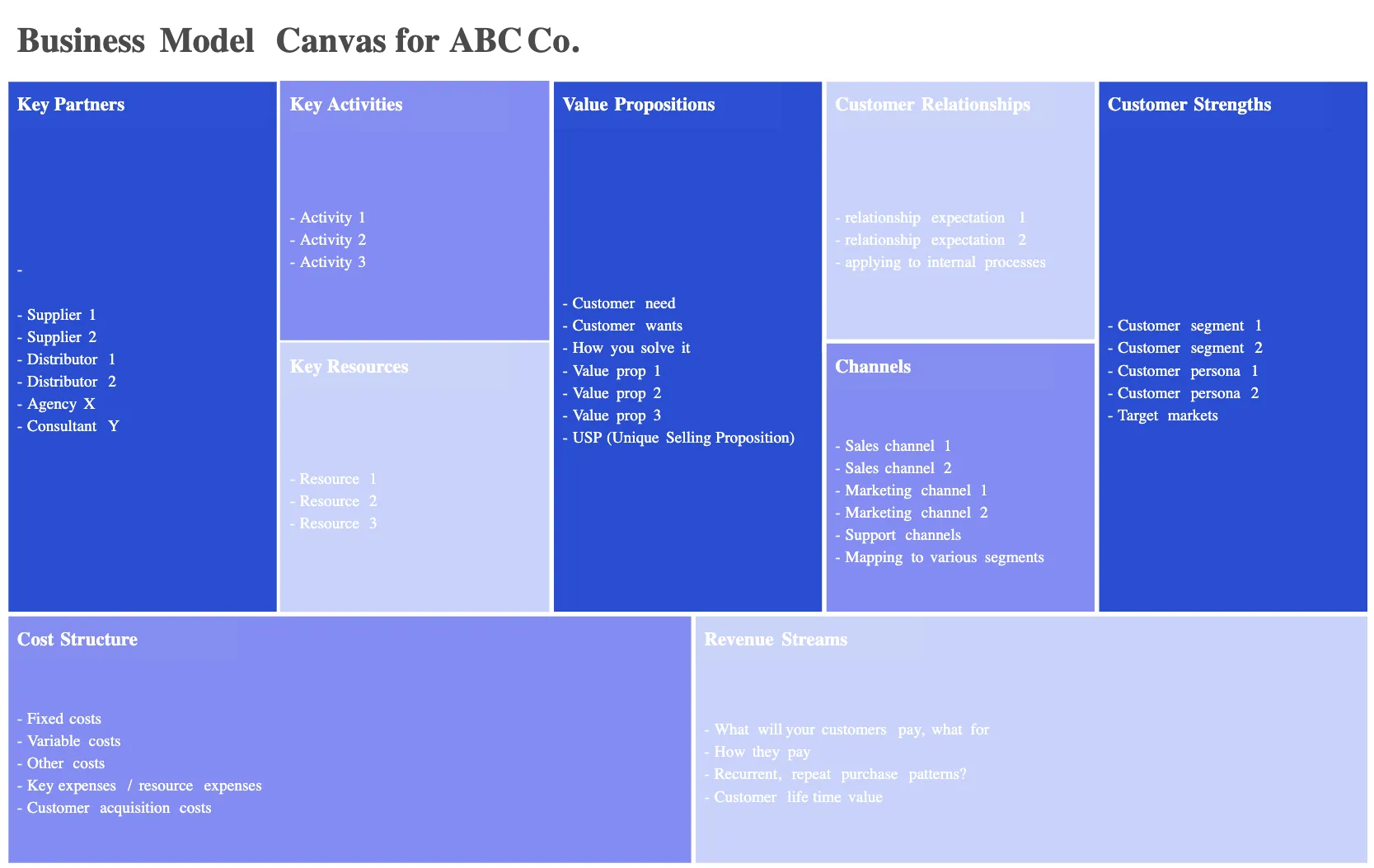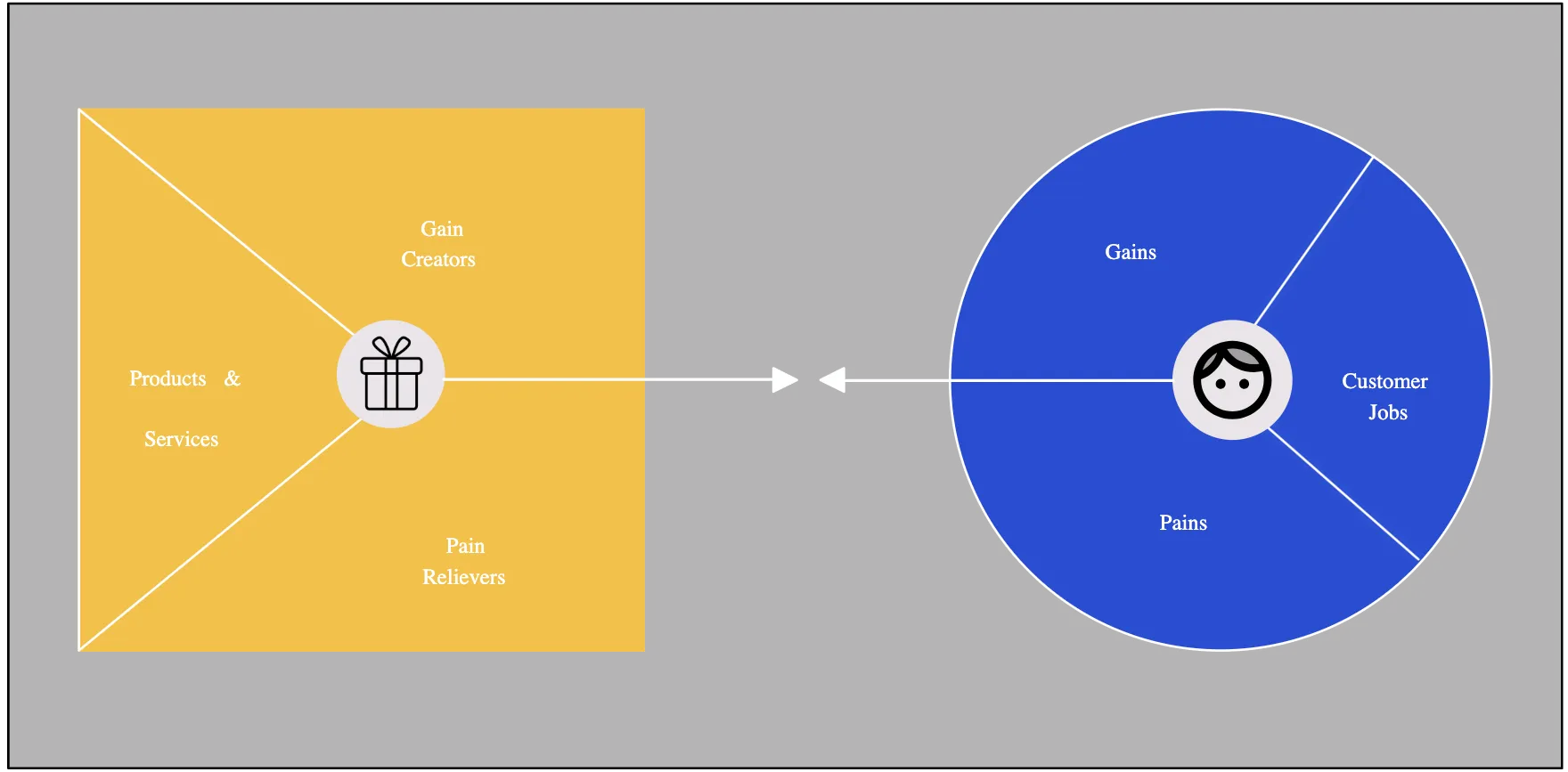Every great business starts with a clear plan—and a clear plan starts with the right tools. The business model canvas and value proposition canvas are two of the most powerful frameworks to help you map your business, uncover opportunities, and understand what truly matters to your customers. In this guide, we’ll show you how to use both canvases to align your team, test ideas, and turn your vision into a practical plan—all in a simple, visual way.
Business Model Canvas (BMC) Overview
The business model canvas is a one-page visual framework that helps you map, design, and analyze your business model. It shows how all the core pieces of your business fit together—customers, value, revenue, resources, and activities—so you can see the big picture, spot opportunities, and make smarter strategic decisions.
Focus: The BMC provides a holistic view of your business model and how all the parts interconnect.
Example: A food delivery startup might use the BMC to outline its operations:
Customer Segments: Busy professionals and students
Value Proposition: Quick, reliable food delivery from local restaurants
Channels: Mobile app and website
Customer Relationships: In-app chat support and loyalty rewards
Revenue Streams: Delivery fees and commissions from partner restaurants
Key Resources: Delivery drivers, app developers, restaurant partnerships
Key Activities: Order management, delivery logistics, marketing
Key Partners: Restaurants, payment gateways, logistics providers
Cost Structure: Driver payments, app maintenance, marketing expenses

Key components
The business model canvas is made up of nine key building blocks, each covering an essential part of your business:
Customer segments – Who are you serving?
Value propositions – What problems are you solving or gains are you creating for them?
Channels – How do you reach and deliver value to your customers?
Customer relationships – How do you interact and build trust with your audience?
Revenue streams – How does your business make money?
Key resources – What assets do you need to deliver your value?
Key activities – What important tasks keep your business running?
Key partnerships – Who helps you make your business work?
Cost structure – What are your main costs and expenses?
Together, these pieces give you a complete snapshot of how your business operates—without getting lost in endless spreadsheets or documents.
Value Proposition Canvas (VPC) Overview
The value proposition canvas is a visual tool that helps you design, test, and refine your value proposition. It focuses on understanding your customers’ jobs, pains, and gains, and mapping your products or services to address them—so you can create offerings that really resonate and drive success.
Focus: Concentrating on understanding customer needs and shaping your value proposition accordingly.
Example: For the same food delivery startup:
Customer Jobs: Ordering food quickly during busy schedules
Pains: Long delivery times, cold food, limited restaurant choices
Gains: Fast delivery, fresh meals, discounts, easy-to-use app
Products & Services: Mobile app for easy ordering and tracking
Pain Relievers: Real-time delivery tracking and nearby restaurant options
Gain Creators: Special deals, loyalty points, personalized recommendations

Key components
The components of the value proposition canvas include;
Customer profile – The people you’re designing for, including:
Jobs – What they’re trying to get done in their work or life
Pains – The challenges, frustrations, or obstacles they face
Gains – The benefits or outcomes they’re hoping for
Value map – How your product or service creates value for them, including:
Products & services – What you offer to help them
Pain relievers – How you reduce their challenges or frustrations
Gain creators – How you help them achieve their desired outcomes
Together, these components ensure your offering is tightly aligned with what your customers truly need.
Value Proposition Canvas vs Business Model Canvas
When you’re mapping out your business, both the business model canvas and value proposition canvas are incredibly useful—but they serve different purposes. Think of the business model canvas as the big picture of how your business works, while the value proposition canvas zooms in on creating products and services that truly fit your customers’ needs. Here’s a comparison of the BMC vs VPC.
| Feature | Business Model Canvas (BMC) | Value Proposition Canvas (VPC) |
| Purpose | Maps the overall business model and how all parts fit together | Focuses specifically on understanding customers and designing value that meets their needs |
| Scope | Broad, covers all aspects of a business | Narrow, focuses on customer segments and value propositions |
| Components | 9 building blocks: customer segments, value propositions, channels, customer relationships, revenue streams, key resources, key activities, key partnerships, cost structure | 2 main blocks: customer profile (jobs, pains, gains) and value map (products/services, pain relievers, gain creators) |
| Focus | Business operations and strategy | Product-market fit and customer value |
| Level of Detail | High-level overview of the business | In-depth exploration of customer needs and value alignment |
| Use Case | Planning, strategy, pivoting business models, communication with stakeholders | Designing, refining, and testing value propositions to ensure product-market fit |
| Visual Layout | One-page canvas showing all building blocks | Two linked sections: customer profile and value map, often used alongside BMC |
| Outcome | Clear picture of the entire business and interdependencies | A refined value proposition that resonates with customers |
How to Integrate the Business Model Canvas and Value Proposition Canvas
Using the business model canvas and value proposition canvas together is like having both a map and a magnifying glass for your business. The BMC gives you the big picture—how your business operates and makes money—while the VPC digs deep into your customers and the value you deliver.
Step 1. Start with the BMC
Sketch out your overall business model. Identify your customer segments and the value propositions you think you offer.
Step2. Zoom in with the VPC
Take each customer segment from your BMC and build a corresponding value proposition canvas. Map out their jobs, pains, and gains, then align your products or services to relieve pains and create gains.
Step3. Refine the BMC
Go back to your BMC and adjust your value propositions, channels, revenue streams, or other blocks based on what you learned from the VPC.
Step4. Iterate
Keep cycling between the two canvases—your big-picture business model and your customer-focused value map—until both are clear, aligned, and realistic.
By combining these tools, you not only see how your business works but also ensure that what you’re offering actually matters to the people you want to serve. It’s a simple way to reduce guesswork and make smarter decisions.
Free Value Proposition Canvas and Business Model Canvas Templates
Whether you’re sketching out a new startup or tweaking an existing model, here are some free templates to save time and keep your thinking organized.
BMC Templates
Coffee Shop Business Model
Restaurant Business Model Canvas
Netflix Business Model Canvas
Nonprofit Organization Business Model Canvas
VPC Templates
Value Proposition Canvas Template
Value Proposition Canvas Example
Value Proposition Canvas for Business Plan
Blank Value Proposition Template
Helpful Resources
Compare the Lean Canvas vs Business Model Canvas and learn how to choose the right one for your business. Explore differences, examples, templates, and step-by-step guidance for startups and established teams.
Easily transform business planning with Creately’s Business Model Canvas Generator — ideal for quickly creating, refining, and collaborating on business models.
Visualize, analyze, and refine your business strategy with Creately’s free value proposition canvas template.
Running a Business Model Canvas and Value Proposition Canvas Workshop with Creately
Creating a Business Model Canvas or Value Proposition Canvas is one thing—getting your team aligned on it is another. Creately makes it fast, interactive, and highly collaborative, helping teams turn ideas into actionable plans.
Key features for effective canvas workshops:
- Ready-made templates – Use pre-built BMC templates and VPC templates, including an AI-powered Business Model Canvas template, to jumpstart your planning.
Creately AI – Generate ideas, refine value propositions, or suggest improvements automatically to speed up your canvas creation.
Shared digital workspace – Collaborate in real time, whether your team is remote or in-office.
Drag-and-drop editing – Easily add, move, or customize shapes, blocks, and connectors.
Notes and annotations – Attach comments, insights, or research directly to any block for context.
Built-in task management – Track action items using integrated tools like Kanban boards, ensuring follow-up and accountability.
Version history and exports – Keep track of iterations, and export canvases as PDFs, images, or shareable links for stakeholders.
Presentation mode – Showcase your canvas directly in meetings without exporting.
Flexible collaboration – Tag team members, comment on specific elements, and iterate ideas in real time.
You can use Creately to create, edit, and share both canvases with ease. Its features help streamline the process: Drag-and-drop templates – Start quickly with ready-made BMC and VPC layouts. Real-time collaboration – Work with your team simultaneously and track updates instantly. Customizable shapes and connectors – Tailor the canvas to fit your unique business needs. Export and share options – Download as PDF, PNG, or share a link with stakeholders. Cloud-based access – Access your canvases anywhere, on any device. When filling out a Business Model Canvas or Value Proposition Canvas, it’s easy to slip into a few common pitfalls: Being too vague – Avoid generic statements like “we offer great service”; be specific about value. Overloading customer segments – Focus on your primary segments rather than trying to serve everyone at once. Skipping customer validation – Don’t assume you know what your customers want; test and iterate. Ignoring interconnections – Ensure value propositions, revenue streams, and activities align across the BMC. Not updating regularly – Business models evolve, so revisit and refine your canvases often.FAQs About the BMC and VPC
Who can benefit from using the VPC and BMC canvases?
Which tool can I use to create a Business Model Canvas and Value Proposition Canvas?
What are common mistakes to avoid when creating these canvases?
How long does it take to fill out a canvas?
Can I use multiple Value Proposition Canvases for one business?
Do I need prior experience to use these canvases?
Can these canvases help with marketing strategy?






